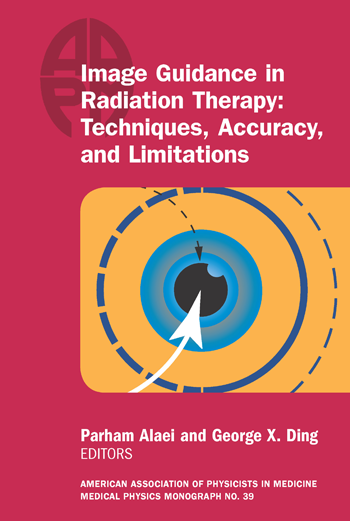
#39 Image Guidance in Radiation Therapy: Techniques, Accuracy, and Limitations, 2018 Summer School
Author: Parham Alaei, George DingISBN: 9781936366620
Published: July 2018 | 406 pp | Hardcover
Price: $ 120.00
AAPM Medical Physics 2021/48(2) | Feb 2021
DESCRIPTION
This book is a part of the proceedings of the American Association of Physicists in Medicine 2018 Summer School. It offers a comprehensive overview of the current technology, application, and development of image guidance in radiation therapy (IGRT). World experts in IGRT contributed chapters that address x-ray, surface, ultrasound, and magnetic resonance (MR) imaging applications in guiding radiotherapy, as well as touching on fundamental algorithms, on-going research, and future directions.
PURPOSE
The purpose of this book is to provide an overview of all important image-guidance technology in the clinics, as well as emerging technologies that will potentially soon become available. This is definitely a much-needed book, as IGRT has become standard practice in our field, but we had not seen a comprehensive summary based on up-to-date technologies, until the arrival of this book. Because of the fast pace of development and expansion of image-guidance technologies, many physicists and trainees have limited or outdated knowledge of IGRT. Therefore, as a community, we very much need a summary reference book like this one. The authors of the book provided a great breadth of IGRT topics, while maintaining the right amount of depth for the majority of readers, with detailed references listed for further reading. The discussion of limitations and future directions is also very interesting for researchers to develop or improve technologies. Overall, the purpose is extremely well fulfilled by the contributing authors and editors.
AUDIENCE
This book suits a wide range audience. Medical physics students and trainees learning about image guidance will find it a great educational reference. It covers the basic principles and clinical applications of various imaging systems. Practicing clinical physicists can refer to it for methodologies to assess imaging system performance and key specifications across current commercial solutions. Last, but not the least, medical physics researchers will find the discussions about limitations very helpful and inspiring to ensure that their research effort addresses pressing clinical needs. The authors who contributed chapters in this book are world experts in their fields. They are certainly credible resources for providing an important overview and detailed information.
CONTENT/FEATURES
The book contains 16 chapters (Ch) that covers the following topics: overview (Ch1), x-ray imaging (Ch2 to Ch5), ultrasound imaging (Ch6), imaging for proton therapy (Ch7), imaging dose (Ch8 to Ch11), surface guidance (Ch12 and Ch13), image guidance for stereotactic treatments (Ch14 and Ch15), and MR guidance (Ch3 and Ch16). These topics comprehensively addressed nearly all aspects of image guidance in radiation therapy. One of the key features that distinguish this book from its peers, is that the authors provided a perfect blend of mathematics, physics, engineering, and application components that grabs the readers’ interest without over-burdening them with too much information in any given area. This feature can be seen throughout all the chapters, but is particularly exemplified in Ch2 and Ch6, where text-book level theory is given in a clean and concise manner followed by very relevant practical components. The book also covered up-to-date technology and development extremely well. Some examples include: Ch3 on dual-energy CT simulation, Ch5 on digital tomosynthesis, Ch7 on proton range verification, and Ch16 on magnetic resonance image guided radiation therapy (MRgRT). Even the latest technologies and commercial systems emerged in the last 1–2 years are also covered, such as Halcyon platform in Ch1, HumediQ in Ch12, and RefleXion in Ch4. Another feature that readers will find very helpful is that the book provided an easy way to compare commercially available systems and options. Some examples are: Ch8 for imaging dose across different vendors and protocols, Ch8 for performance data on different surface guidance solutions, and Ch16 on MRgRT systems. Clinical physicists will find this tabulated data very convenient and informative when making purchase decisions, choosing treatment and imaging techniques, and estimating clinical impact from different systems. As for the weakness of this book, there is some minor overlap between imaging dose measurement methods across different chapters. And, I would have loved to see a bit more detailed information on MR imaging theory and widely used pulse design in the chapters related to MR guidance. However, these weaknesses do not detract from the quality of the book.
ASSESSMENT/COMPARISON
In summary, this is a much-needed book that a wide range of audience in the medical physics community will find very useful to have. It is a very timely summary of IGRT technology that will be found extremely helpful by a wide range of readers, including students, trainees, clinicians, and researchers. Clinicians will appreciate the up-todate information about the current stateof- the-art systems, including specifications and applications; researchers will find the discussion on the fundamental algorithms and current limitations inspiring and helpful; and most importantly, students and trainees will benefit vastly from the comprehensiveness and superb clarity, especially for those preparing for board examinations. The contents are arranged very logically with minimal overlap between chapters. References, illustrations, and system specifications are comprehensive and up-to-date. The level of detail and depth of information is well balanced by the authors with great clarity. It was genuinely an enjoyment to read this book, and to have it as a reference for routine clinical, education, and research needs. It is a must-have for trainees preparing for the American Board of Radiology board exams. To the best of my knowledge, there is not an equivalent or comparable book on the market that is similarly complete or current. Therefore, I highly recommend this book to all medical physicists.
Reviewed by Taoran Li, PhD
Taoran Li is an Assistant Professor in the
Department of Radiology Oncology at
University of Pennsylvania. He is the Director
of the Medical Physics Residency Program
and active in research and
development of new technologies in Radiation
Therapy.


